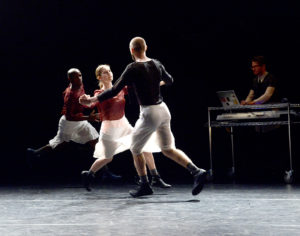Toronto Dance Theatre: Christopher House / Mixed Bill - Vancouver Ballet Society
- Home
- Reviews 2014 - 2019
- Toronto Dance Theatre: Christopher House / Mixed Bill

For its 50th-anniversary season, Toronto Dance Theatre toured in Canada and to South America with a program of works created by artistic director Christopher House over his 24 years at the company’s helm.
Entitled House Mix, the evening was truly a mixed bill. Some works were clean and crisp, some stark, some classic and some mesmerizing in their repetitive nature. However, all were crystallized, deeply physical, and performed with presence and panache by 12 of the company dancers. If there is one word to describe the show overall, and House’s works generally, perhaps it would be elegance, in the scientific sense: simple and effective. House has a skill for distilling a work down to its essence, using form, timing and space clearly, and highlighting both the diversity and unity of the cast.
Martingales (2014) was perhaps the most obvious example of this elegance: a straightforward but engaging medley of ball tossing, running, spiralling and looping. With an electronic score performed live by Thom Gill, the piece began with dancers nonchalantly tossing and catching balls. The music switched from ambient sound to a driving three-quarter rhythm, urging the dancers into a complex running pattern of spirals and loops, sometimes solo, sometimes in pairs face to face and holding hands, with one partner running backward. Entrances, exits, pairings and partings were perfectly co-ordinated. From a final organized chaos of catching, sinking, whirling and tossing, the work dissolved as it began, with balls and dancers gradually dropping out, in what was a somewhat anticlimactic end, though the simplicity seemed appropriate.
Excerpts from one of House’s earliest works, Fjeld (1990), followed. The female duet featured elegant, circular movement and unembellished gestures — a hand on a shoulder, a head in a lap — to portray a somewhat stereotypically feminine quality. The male trio was a series of tableaux of bodies, nude from the waist up, draped over and entwined with one another. Moments of vulnerability — an exposed ribcage, underarm, throat — provided a less clichéd view of masculinity, and created a desire for the female duet to have the same scope.
It was a reminder that we were viewing a retrospective — many of these works were created in a very different time. In some ways it is unfair to look at them through a 2018 lens, but, simultaneously, it is impossible not to, and watching some of the older works in the context of #MeToo and other social movements intensifies the gender stereotypes. It is, however, interesting to note a distinct contrast between the more traditional gender divisions in the older works, and the clear and intentional androgyny of the newer and remixed works. Costumes for four of the five pieces are basically unisex, and dancer roles are much more uniform.
In both Thirteen and Echo Dark, House returned to works from his early TDT career, deconstructing, reconstructing, re-working and re-imagining them for today. Thirteen involved a more complete undoing of form and structure, allowing the dancers to explore — in an improvisational context and in just 10 minutes — the movement language taken from what has been called a signature work, Glass Houses (1983). One dancer introduced a movement idea and then all three riffed on this, played with it, challenged one another, reinvented the idea throughout the space until the next idea was proposed and the process repeated. Christianne Ullmark was a standout — crisp and specific in her movement, while simultaneously assertive and playful.
Echo Dark, a reimagining of Echo’s Object (2005), was the standout piece on the program. With stark and unchanging lighting and sound, the build of the work was carried entirely by House’s masterful sense of timing, use of pause and element of surprise. The five dancers began planted on the spot, wearing huge army-green canvas skirts. Their arms and torsos moved in contorted, bound and stilted arcs. When they suddenly turned and started travelling upstage with a dramatic arching kick, the military boots beneath their skirts were a surprise, and were used to dramatic effect throughout.
House’s 1998 Vena Cava is an understandable choice to close the program: an athletic, large ensemble work with a driving score and a relentlessly fast pace. The dancers hardly pause for a moment, and their presence, clarity and acuity are palpable. A solo by Erin Poole two-thirds of the way through was a welcome and needed change of pace: her fluid, supple movements evoked a praying mantis — long-limbed, precise and calculated. The solo provided an opportunity to zero in on the individual before a return to the rush and chaos of the group.
It was revealing to see House’s works stacked up together against one another. We witnessed, in one evening, both the evolution and continuity of a choreographic aesthetic, and saw firsthand how the definition of the word elegance can change over time.
— KATE STASHKO
DI SUMMER 2018

Photo: Guntar Kravis
